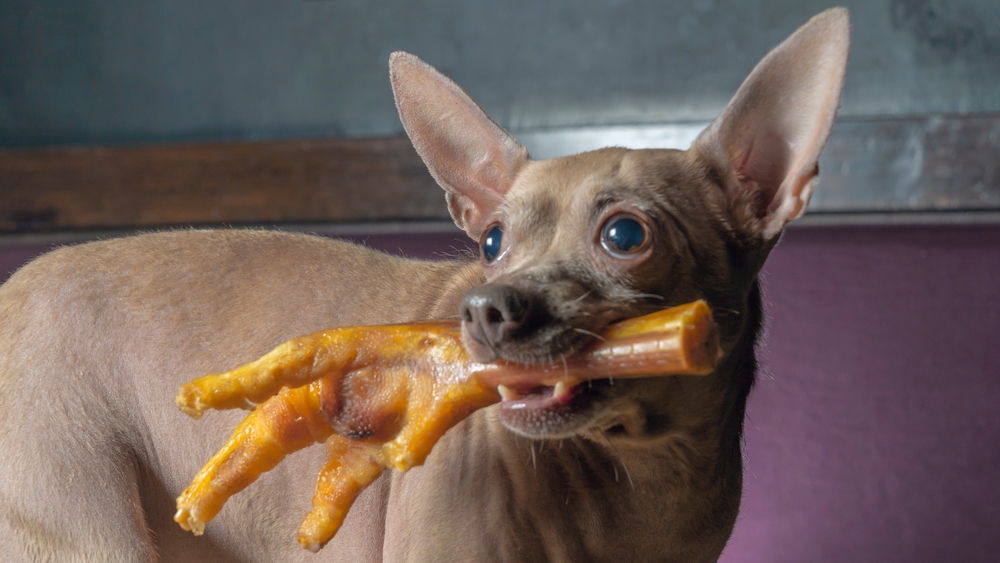As a proud pet lover and occasional doggy snack taster (kidding!), we often find ourselves asking what our furry companions can and cannot eat. Dogs have a keen nose and are incredibly curious about what we eat, especially if it involves something that smells delicious, like chicken! But can dogs eat cooked chicken skin? This is an important question that we need to address.
Cooked chicken skin has many appealing qualities — it’s crispy, juicy, and packed with flavor. However, we need to think about our pets’ health. Can Dogs eat cooked chicken skin? The answer is Yes, but there are a few things we need to consider before we toss that leftover skin to our furry friends. While chicken skin is safe in moderation, it’s not the healthiest treat for our canine pals. It often comes loaded with fats, which could lead to weight gain or even digestive problems.
In this article, we’ll explore the ins and outs of chicken skin consumption for your dog, including the benefits and risks. Do read on!
Can Dogs Eat Chicken Skin?
As we gather around the dinner table and enjoy a delightful roast chicken, it is hard to resist the allure of that crispy chicken skin! But before we offer a bite to our furry friends, it is essential to weigh the pros and cons of giving them cooked chicken skin. Dogs are like curious little detectives, sniffing around and begging for a tasty morsel. However, we need to remember that not all human foods are suitable for our pets. So, can dogs eat cooked chicken skin? Let’s explore this deliciously crispy question!
Cooked chicken skin is generally safe for dogs in small amounts. After all, dogs are carnivores at heart, and chicken is a type of meat they naturally would consume. It contains protein, which is crucial for maintaining strong muscles and energy levels. However, we should bear in mind that chicken skin is high in fat, which may lead to extra calories. If your pooch is begging with those big pleading eyes, it’s easy to give in. But moderation is key here! Too much chicken skin can lead to obesity or pancreatitis in dogs, which is a condition that results from inflammation of the pancreas due to high-fat foods.
So the answer is yes, dogs can eat cooked chicken skin, but it should be offered sparingly. We need to ensure that our furry companions have a balanced diet that does not compromise their health. Lean meat is often a better option for dogs when it comes to the chicken dinner. Now that we’ve spotted the chicken skin conundrum, let’s take a deeper look into how much chicken skin we can share without worry.
How Much Chicken Skin Can Dog Eat
Now that we know dogs can eat cooked chicken skin, we need to be conscientious about how much we serve them. A good rule of thumb when sharing chicken skin is moderation. Since our pets come in all shapes and sizes, what is a safe portion for a chubby Beagle might not suit a tiny Chihuahua! The amount of chicken skin we can give should vary based on the dog’s size, weight, and overall health.
For small dogs, like Chihuahuas and Yorkies, it’s best to treat them to a tiny piece of chicken skin — think about the size of a pea! For medium-sized dogs like Beagles or Cocker Spaniels, half of the skin might be a reasonable way to go. Large dogs, such as Golden Retrievers or German Shepherds, could handle a full piece, but even then, we should be cautious. Overindulgence can lead to unpleasant gastrointestinal issues or weight gain.
It’s also essential to remember that giving chicken skin should not become a regular habit. Instead, consider it an occasional treat or special reward for good behavior. As responsible pet parents, we have to look after our furry companions’ diets while still being a fun source of tasty snacks. Always make sure that the chicken skin is from plain, cooked chicken with no sauces, seasonings, or spices that could harm your dog’s digestive system.
Make sure to observe how your dog reacts to chicken skin; if they show signs of distress, like vomiting or diarrhea, it’s best to skip this treat in the future. Chicken skin may not be suitable for every pup, especially those with pre-existing health conditions. If your dog is overweight or has a history of pancreatitis, it’s best to keep the chicken skin at bay.
In conclusion, dogs can eat cooked chicken skin, but only in moderation and in accordance with their size and health. Always put your pet’s health first and seek out healthier alternatives for their snacks. Giving chicken skin as an occasional reward can create special moments of joy without compromising their well-being!
Benefits of Chicken Skin To Dogs
Nutritional Value
One of the key benefits of cooked chicken skin is its nutritional value. It contains protein, which is essential for our dogs’ growth, maintenance, and energy levels. Protein is the building block of muscles and cells, allowing our furry friends to live active and happy lives. Moreover, chicken skin has certain vitamins and minerals such as Vitamin B6, which aids in their metabolism and brain function.
Tasty Treat
Let’s not forget how tasty chicken skin can be! Dogs love savory flavors, and the crispy texture can provide a delightful crunch. When we offer our dogs some chicken skin, we help create that beautiful bond while providing them with a satisfying treat. Imagine their wagging tails and happy faces as they savor a little piece of chicken goodness! Sharing food can be a powerful way to express love and attention to our furry family members.
Training Reward
Chicken skin can be a great high-value training reward! Sometimes, we need a little extra motivation to get our dogs to learn new tricks or commands. The aroma of chicken skin can make our furry pals perk up their ears. Using a tiny bit of chicken skin as a reward can help pups respond positively and stay focused during training sessions. However, we need to ensure that we balance it with their regular kibble to avoid excess calories in their daily meals.
Bonding Time
Cooking for our pets can be such a heartwarming experience! By preparing chicken for our furry companions, we not only show love but also create moments of connection. Sitting down with our dog as they enjoy a small piece of chicken skin is a small gesture that fosters that delightful pet-owner bond. Nothing quite like sharing food brings us closer as a family!
Alternatives
Now, while cooked chicken skin has its benefits, there are certainly great alternatives to consider. If we notice our dogs enjoying the taste of chicken, we can prepare lean, boneless chicken meat instead. This way, we can offer a healthy protein source without the extra fat. Lean meats are nutritious and can be prepared without any harmful seasonings. When we’re looking out for our furry friends, the options are endless!
Risks/Dangers of Feeding Chicken Skin to Dogs
High Fat Content
While cooked chicken skin can be tempting, one of the primary risks is its high-fat content. Feeding our dogs too much fatty food can lead to obesity over time, leading to serious health problems. We want to prevent our furry pals from struggling with weight-related issues or other disorders brought on by too much fat in their diets. It is vital to be aware of this when considering cooked chicken skin as a treat.
Digestive Problems
Another significant concern is the potential for gastrointestinal distress. Since chicken skin is high in fat, some dogs may have difficulty digesting it, leading to stomach upset, vomiting, or diarrhea. This can be especially true for dogs with sensitive stomachs or pre-existing digestive issues. If our dogs exhibit these symptoms after consuming chicken skin, we should definitely avoid giving it to them in the future.
Pancreatitis Risk
One of the more serious risks of feeding dogs high-fat foods like chicken skin is the danger of pancreatitis. When dogs consume excess fat, it can cause inflammation in the pancreas, leading to a painful condition. Signs of pancreatitis may include lack of appetite, abdominal pain, vomiting, and lethargy. If we ever notice our dogs experiencing these symptoms, we must contact a veterinarian right away for guidance.
Triggers for Allergies
For some dogs, chicken can even cause allergies. If our pups are allergic to chicken or certain ingredients in the skin, eating it could lead to unpredictable allergic reactions. Signs of an allergic response in dogs may include itching, rashes, or gastrointestinal upset. If we ever suspect any food allergies, we should consult our veterinarian to identify the root cause.
Not Balanced Nutrition
As responsible pet owners, we must always focus on providing a balanced diet for our pups. Offering too many treats like cooked chicken skin can lead to nutritional deficiencies if it means our dogs are not getting enough essential nutrients from their regular dog food. Treats should only be a tiny part of our dogs’ diets. If we do choose to give a bit of chicken skin, it’s essential to ensure it doesn’t replace their balanced meals.
Chicken Skin Alternatives For Dog
Lean Chicken Meat
If our dogs catch the scent of chicken while we cook, they might crave some yummy bites! The best alternative to chicken skin is lean chicken meat. This option allows us to feed our furry friends protein while avoiding excess fat. Simply debone cooked chicken breast and serve it without any spices or seasonings. This option is not just healthy but often preferred due to its tender texture!
Vegetables
In addition to lean chicken meat, we can introduce a variety of dog-safe veggies into their diets. Carrots, green beans, and sweet potatoes are great alternatives that provide key vitamins and minerals. Not only do these vegetables promote better digestion, but they can also be a crunchy and fun treat for our pups! We can always experiment with different vegetables to find out what they love best.
Commercial Treats
Another awesome substitute option is to explore high-quality commercial dog treats. Many brands offer treats specifically designed for canines, which guarantee balanced nutrition while still being delectable. Just make sure to check the ingredient list so we can ensure it’s made from natural ingredients. We want our pups to enjoy tasty snacks while also supporting their health.
Fruit Snacks
Fruit can also be an entertaining and healthy treat for our dogs. Apples (without seeds), blueberries, and bananas can be delightful snacks that offer essential vitamins and hydration. Always ensure when giving fruits to our furry friends, we take the necessary precautions and avoid harmful options like grapes or avocados. Fruits can serve as remarkably refreshing snacks on a warm day!
Frozen Treats
On hot days, frozen treats can provide cooling refreshment for our pets! We can create homemade frozen delights using plain yogurt, pureed fruits, or even chicken broth. Pouring these mixtures into ice cube trays and letting them freeze can result in fun and delightful snacks for our furry friends. After all, they deserve some sunny day treats!
Frequently Asked Questions
What if my dog ate too much chicken skin?
If your dog happens to eat too much chicken skin, it’s best to keep an eye on them for any signs of distress, such as vomiting or diarrhea. If you notice any unusual behavior, contact your veterinarian for advice on what to do next. They can recommend appropriate steps to help your pup shake off any tummy troubles.
Is chicken skin bad for all dogs?
Not all dogs will have an adverse reaction to chicken skin, but it’s high in fat, so moderation is key! Some dogs may have an easier time digesting it than others, while some may be more prone to weight gain or pancreatitis. Always be mindful of each dog’s unique health needs.
Can I use chicken skin as a reward during training?
Absolutely! If your dog does not have any health issues and seems to enjoy chicken skin, you can use a tiny piece as a high-value training reward. Just be cautious with the portion size and ensure it does not replace their regular foods.
What signs should I look for if my dog has eaten chicken skin?
Look out for any signs of discomfort such as excessive drooling, vomiting, diarrhea, lethargy, or a decreased appetite. If you notice any of these symptoms, it’s important to consult a vet immediately to determine the necessary course of action.
Can my dog eat raw chicken skin?
Raw chicken skin can pose a risk because of harmful bacteria like Salmonella. It’s best to avoid giving any raw chicken to dogs to reduce the risk of infections. Cooked chicken skin is the safer option, but it should still be given in moderation to avoid health issues.
Final Thoughts
In summary, yes, dogs can eat cooked chicken skin, but moderation is key. It can be a delicious treat packed with protein that our furry friends love. However, it comes with risks such as high fat content and potential digestive issues. As responsible pet owners, we should keep their health in mind and provide balanced nutrition without compromising their diets.
The best approach is to give chicken skin sparingly and consider healthier substitutes while ensuring our furry pals get enough exercise to maintain a healthy weight. We are all in this together, ensuring our pets are happy and healthy while enjoying some of the tasty treats we often have at home!





